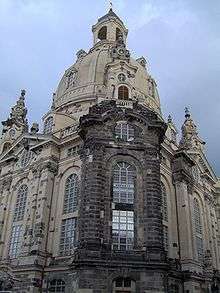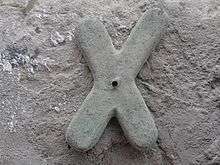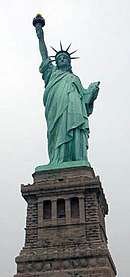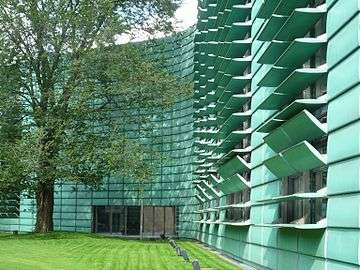Patina
Patina /pəˈtiːnə/) or (/ˈpætɪnə/ is a thin layer that variously forms on the surface of copper, brass, bronze and similar metals (tarnish produced by oxidation or other chemical processes), or certain stones,[1] and wooden furniture (sheen produced by age, wear, and polishing), or any similar acquired change of a surface through age and exposure.



Additionally, the term is used to describe the aging of high-quality leather. The patinas on leather goods are unique to the type of leather, frequency of use, and exposure.
Patinas can provide a protective covering to materials that would otherwise be damaged by corrosion or weathering. They may also be aesthetically appealing.
Usage
On metal, patina is a coating of various chemical compounds such as oxides, carbonates, sulfides, or sulfates formed on the surface during exposure to atmospheric elements (oxygen, rain, acid rain, carbon dioxide, sulfur-bearing compounds), a common example of which is rust which forms on iron or steel when exposed to oxygen, or more specifically the surface that develops on weathering steel). Patina also refers to accumulated changes in surface texture and color that result from normal use of an object such as a coin or a piece of furniture over time.[2]
Archaeologists also use the term patina to refer to a corticated layer that develops over time that is due to a range of complex factors on flint tools and ancient stone monuments.[1] This has led stone tool analysts in recent times to generally prefer the term cortification as a better term to describe the process than patination.[3]
In geology and geomorphology, the term patina is used to refer to discolored film or thin outer layer produced either on or within the surface of a rock or other material by either the development of a weathering rind within the surface of a rock, the formation of desert varnish on the surface of a rock, or combination of both. It also refers to development as the result of weathering of a case-hardened layer, called cortex by geologists, within the surface of either a flint or chert nodule.[4][5]
Etymology
The word patina comes from the Italian patina (shallow layer of deposit on a surface) derived from the Latin patĭna (pan, shallow dish). Figuratively, patina can refer to any fading, darkening or other signs of age, which are felt to be natural or unavoidable (or both).
The chemical process by which a patina forms or is deliberately induced is called patination, and a work of art coated by a patina is said to be patinated.

Acquired patina

The green patina that forms naturally on copper and bronze, sometimes called verdigris, usually consists of varying mixtures of copper chlorides, sulfides, sulfates and carbonates, depending upon environmental conditions such as sulfur-containing acid rain.[6][7][8][9] In clean air rural environments, the patina is created by the slow chemical reaction of copper with carbon dioxide and water, producing a basic copper carbonate. In industrial and urban air environments containing sulfurous acid rain from coal-fired power plants or industrial processes, the final patina is primarily composed of sulphide or sulphate compounds.[10][11][12]
A patina layer takes many years to develop under natural weathering. Buildings in damp coastal/marine environments will develop patina layers faster than ones in dry inland areas.
Facade cladding (copper cladding; copper wall cladding) with alloys of copper, e.g. brass or bronze, will weather differently from "pure" copper cladding. Even a lasting gold colour is possible with copper-alloy cladding, for example Colston Hall in Bristol, or the Novotel at Paddington Central, London.
Often, antique and well-used firearms will develop a patina on the steel after the bluing, parkerizing, or other finish has worn. Firearms in this state are generally considered more valuable than ones that have been re-blued or parkerized. The patina protects the firearm from the more damaging rust that would occur were the patina to be polished off.
Applied patina
Artists and metalworkers often deliberately add patinas as a part of the original design and decoration of art and furniture, or to simulate antiquity in newly made objects. The process is often called distressing.
A wide range of chemicals, both household and commercial, can give a variety of patinas. They are often used by artists as surface embellishments either for color, texture, or both. Patination composition varies with the reacted elements and these will determine the color of the patina. For copper alloys, such as bronze, exposure to chlorides leads to green, while sulfur compounds (such as "liver of sulfur") tend to brown. The basic palette for patinas on copper alloys includes chemicals like ammonium sulfide (blue-black), liver of sulfur (brown-black), cupric nitrate (blue-green) and ferric nitrate (yellow-brown). For artworks, patination is often deliberately accelerated by applying chemicals with heat. Colors range from matte sandstone yellow to deep blues, greens, whites, reds and various blacks. Some patina colors are achieved by the mixing of colors from the reaction with the metal surface with pigments added to the chemicals. Sometimes the surface is enhanced by waxing, oiling, or other types of lacquers or clear-coats. More simply, the French sculptor Auguste Rodin used to instruct assistants at his studio to urinate over bronzes stored in the outside yard. A patina can be produced on copper by the application of vinegar (acetic acid). This patina is water-soluble and will not last on the outside of a building like a "true" patina. It is usually used as pigment.


Patina is also found on slip rings and commutators. This type of patina is formed by corrosion, what elements the air might hold, residue from the wear of the carbon brush and moisture; thus, the patina needs special conditions to work as intended.
Patinas can also be found in woks or other metal baking dishes, which form when properly seasoned. The patina on a wok is a dark coating of oils that have been burned onto it to prevent food sticking. Steaming foods or using soap on a wok or other dishware could damage the patina and possibly allow rust.
Knife collectors that own carbon steel blades sometimes force a patina onto the blade to help protect it and give it a more personalized look. This can be done using various chemicals and substances such as muriatic acid, apple cider vinegar, or mustard. It can also be done by sticking the blade into any acidic vegetable or fruit such as an orange or an apple. Nekonoshoben, a Japanese technique, has been traditionally used to force stable blue patinas onto Japanese kitchen knives.
Repatination
In the case of antiques, a range of views are held on the value of patination and its replacement if damaged, known as repatination.
Preserving a piece's look and character is important and removal or reduction may dramatically reduce its value. If patination has flaked off, repatination may be recommended.[14] Appraiser Reyne Haines notes that a repatinated metal piece will be worth more than one with major imperfections in the patina, but less than a piece still with its original finish.[14]
See also
References
- European Geosciences Union. General Assembly; Přikryl, Richard; Smith, Bernard J.; Geological Society of London (2007). Building Stone Decay: From Diagnosis to Conservation. Geological Society. pp. 295–. ISBN 978-1-86239-218-2. Retrieved 26 September 2012.
- "Finish issues with regard to copper sinks". October 2010.
- Edmonds, Mark (2 June 1997). Stone Tools and Society: Working Stone in Neolithic and Bronze Age Britain. Psychology Press. pp. 192–. ISBN 978-0-415-21449-0. Retrieved 26 September 2012.
- Neuendorf, K.K.E., J.P. Mehl, Jr., and J.A. Jackson, J.A., eds. (2005) Glossary of Geology (5th ed.). Alexandria, Virginia, American Geological Institute. 779 pp. ISBN 0-922152-76-4
- Twidale, C.R., and J.R. Vidal Romani (2005) Landforms and Geology of Granite Terrains. A.A. Balkema Publishers Leiden, The Netherlands. 330 pp. ISBN 0-415-36435-3
- Oxidation Reaction: Why is the Statue of Liberty Blue-Green? Engage Students in Engineering; www.EngageEngineering.org; Chun Wu, Ph.D., Mount Marty College; Funded by the National Science Foundation (NSF) under Grant No. 083306. https://web.archive.org/web/20131025094519/http://www.wepanknowledgecenter.org/c/document_library/get_file?folderId=517&name=DLFE-2454.pdf
- Fitzgerald, K.P.; Nairn, J.; Atrens, A. (1998). "The chemistry of copper patination". Corrosion Science. 40 (12): 2029–2050. doi:10.1016/S0010-938X(98)00093-6.
- Application Areas: Architecture - Finishes – patina; http://www.copper.org/applications/architecture/finishes.html
- Glossary of copper terms, Copper Development Association (UK): "Archived copy". Archived from the original on August 20, 2012. Retrieved September 14, 2012.CS1 maint: archived copy as title (link)
- Berg, Jan. "Why did we paint the library's roof?". Archived from the original on 2007-06-25. Retrieved 2007-09-20.
- Architectural considerations; Copper in Architecture Design Handbook, http://www.copper.org/applications/architecture/arch_dhb/fundamentals/arch_considerations.htm
- Peters, Larry E. (2004). Preventing corrosion on copper roofing systems; Professional Roofing, October 2004, http://www.professionalroofing.net
- Nordic Embassies Berlin : Architecture Information, http://www.e-architect.co.uk/berlin/scandinavian_embassies.htm
- Gaffney, Dennis (May 19, 2009). "What "Patina" Really Means".
Further reading
- Angier, R.H. : Firearm Blueing and Browning, Onslow County 1936.
- Fishlock, David : Metal Colouring, Teddington 1962.
- Hiorns, Arthur (1907). Metal Colouring and Bronzing. London.
- Hughes, Richard; Rowe, Michael (1995). The Colouring, Bronzing and Patination of Metals. London: Thames & Hudson Ltd. ISBN 978-0-500-01501-8.
- LaNiece, Susan; Craddock, Paul : Metal Plating and Patination: Cultural, Technical and Historical Developments, Boston 1993.
- Pergoli Camopanelli, A. : The value of patinaon the antiques market – Affinities and relationships between conservation theories and buyers' taste: NEWS IN CONSERVATION, (31), 2012.
- Sugimori,E. : Japanese patinas, Brunswick 2004.
External links
| Look up patina in Wiktionary, the free dictionary. |
- . Encyclopædia Britannica. 20 (11th ed.). 1911.
- W.A. Franke, M. Mircea Plutarch report on the blue patina of bronze statues at Delphi: A scientific explanation
- A. Giumlia-Mair Alchemy_and_Surface_Treatments_in_Antiquity
- Cockrell, B. Colourful Corrosion:Black Bronze and its Enigmatic Patina
- Patina on Bronze Sculpture From the Historical-Artistic Point of View
